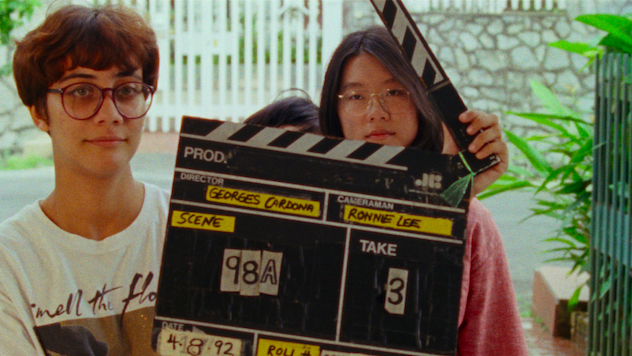Roll film, and “action.” 1992 Singapore. A teenage girl (played by Sandi Tan) wearing a pink sailor top ambles gingerly through a quaint neighborhood. Instead of skyscrapers, the landscape is populated with rice paddies, tropical plants, crumbling colonial buildings and a rickety old train. Carrying a briefcase and an old camera, she sets off on her quest to kill the people who have stolen her heart.
She passes whimsical characters, like funny old men, languidly smoking mothers, an oversized boy on a tiny bike. The neighbors seem kind and warm. The accompanying music is dreamy indie rock, and a voice — made rough like sandpaper with the passage of time and bitterness — is heard. It’s the voice of a now middle-aged Sandi Tan.
“Shirkers,” now streaming on Netflix, is a documentary about the narrative film of the same name that Tan made 25 years earlier. She explained that Singapore was so restricted that she couldn’t watch indie movies or listen to punk rock, which was popular in the U.S. and in England. She loved new wave counterculture, but was so frustrated that she couldn’t find expressions of it anywhere in Singapore.
She and her partner-in-crime, Jasmine Ng Kin Kia, decided to take a filmmaking class. The teacher was an older dude named Georges Cardona with chilling blue eyes and a soft, calming voice. After class, he drove them around and made grainy videos of dogs having sex. He showed them cool foreign films. He taught them how to make movies and how to love movies.
They were so inspired they decided to make their own movie: “Shirkers.” Cardona would be the director. Tan wrote the script. Ng was the video editor, and Sophie Siddique, a willowy and intelligent girl they met in film class, was the producer. Cardona insisted that they only shoot during the magic hour, which is just before the sun sets, to cast a lemony yellow glow.
In the snippets that appear in the documentary, “Shirkers” recalls the work of Wes Anderson, with its saturated colors, quirky set design and eccentric characters. But what made it even cooler than a movie by Anderson was that it had all these regular Asian people — not big, fancy movie stars, but real people — plucked from Tan’s own life. It featured a huge Hawaiian shirt-clad wolfhound led around by a nurse and her epileptic daughter.
The young filmmakers graduated high school and went abroad for university, entrusting the film’s completion to Cardona, who reassured them that the movie was in the final stages of editing. The Cannes Film Festival was interested. And then, Cardona disappeared without a trace, taking all 70 reels of the precious film with him.
In the film’s third act, Tan, now a grown woman, novelist and filmmaker, begins her own quest: heading south to Louisiana to solve the mystery of Cardona and why he absconded with their most precious creation. I won’t spoil the ending for you. But from the moment the film begins to when the final credits roll, the documentary uses the tools of storytelling to probe the big questions of art: What is an artist? What inspires art? And what processes and circumstances determine who gets to create and who must simply watch and learn?






